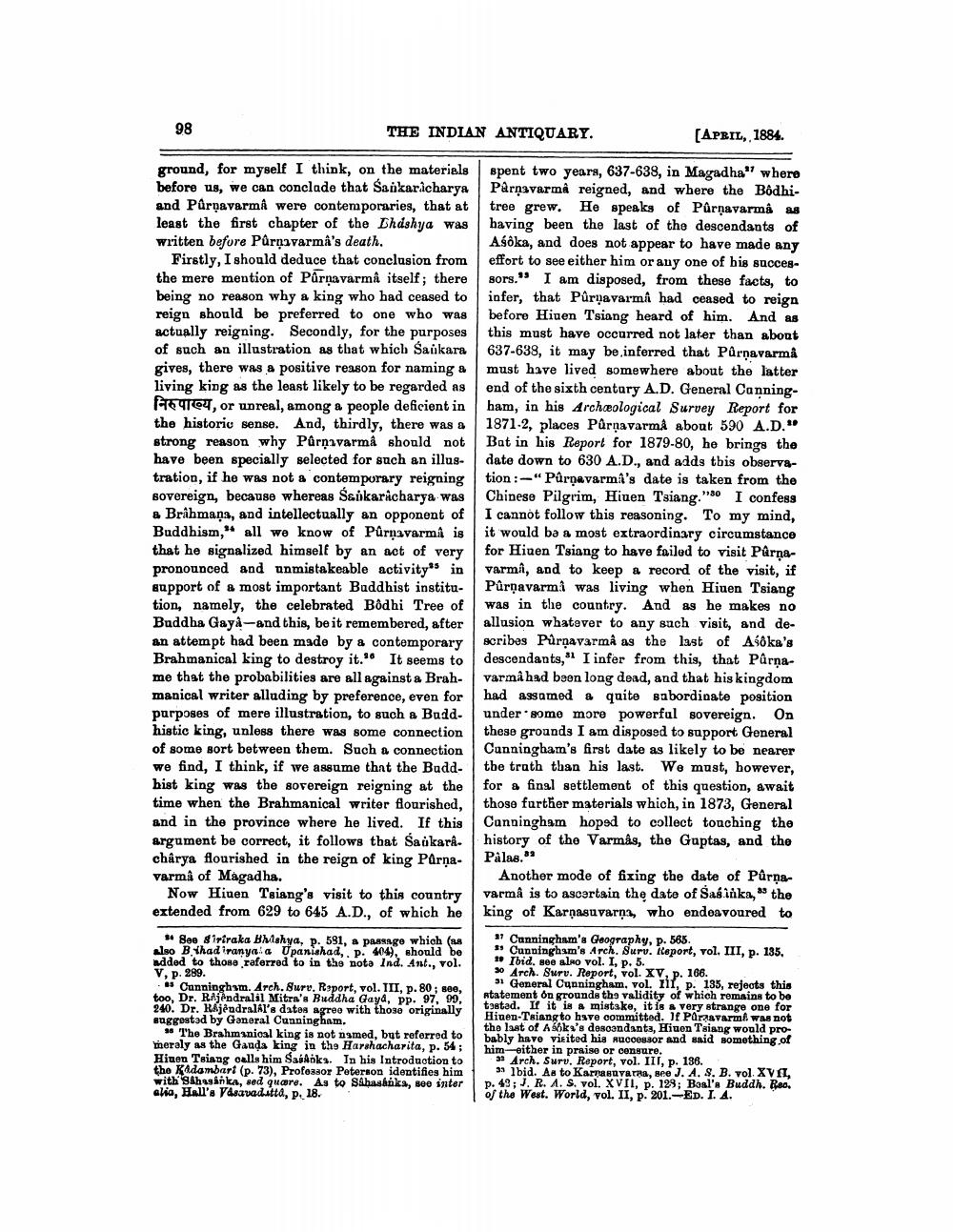________________
98
THE INDIAN ANTIQUARY.
ground, for myself I think, on the materials before us, we can conclude that Sankaracharya and Purṇavarmâ were contemporaries, that at least the first chapter of the Bhashya was written before Pûrṇavarma's death.
Firstly, I should deduce that conclusion from the mere mention of Purnavarmâ itself; there being no reason why a king who had ceased to reign should be preferred to one who was actually reigning. Secondly, for the purposes of such an illustration as that which Sankara gives, there was a positive reason for naming a living king as the least likely to be regarded as
a
464, or unreal, among a people deficient in the historic sense. And, thirdly, there was strong reason why Purnavarma should not have been specially selected for such an illustration, if he was not a contemporary reigning sovereign, because whereas Sankaracharya was a Brahmans, and intellectually an opponent of Buddhism, all we know of Pûrnavarma is that he signalized himself by an act of very pronounced and unmistakeable activity in support of a most important Buddhist institution, namely, the celebrated Bodhi Tree of Buddha Gaya-and this, be it remembered, after an attempt had been made by a contemporary Brahmanical king to destroy it. It seems to me that the probabilities are all against a Brahmanical writer alluding by preference, even for purposes of mere illustration, to such a Buddhistic king, unless there was some connection of some sort between them. Such a connection we find, I think, if we assume that the Buddhist king was the sovereign reigning at the time when the Brahmanical writer flourished, and in the province where he lived. If this argument be correct, it follows that Saukarâ. charya flourished in the reign of king Pârnavarma of Magadha.
34
Now Hiuen Tsiang's visit to this country extended from 629 to 645 A.D., of which he
See Siriraka Bhishya, p. 581, a passage which (as also Bthadiranya a Upanishad,, p. 404), should be added to those referred to in the note Ind. Ant., vol. V, p. 289.
as Cunningham. Arch. Surv. Report, vol. III, p. 80; see, too, Dr. Rajendralil Mitra's Buddha Gaya, pp. 97, 99, 240. Dr. Rajendralal's dates agree with those originally suggested by General Cunningham.
38 The Brahmanical king is not named, but referred to meraly as the Gauda king in the Harshacharita, p. 54; Hiuen Tsiang calls him Saskoks. In his Introduction to the Kadambart (p. 73), Professor Peterson identifies him with Sahasinka, sed quare. As to Sahasánka, see inter alia, Hall's Vasavaditto, p. 18.
[APRIL,, 1884.
spent two years, 637-638, in Magadha" where Pârnavarma reigned, and where the Bôdhitree grew. He speaks of Pûrṇavarma as having been the last of the descendants of Aśoka, and does not appear to have made any effort to see either him or any one of his successors." I am disposed, from these facts, to infer, that Pûrnavarmâ had ceased to reign before Hiuen Tsiang heard of him. And as this must have occurred not later than about 637-638, it may be inferred that Purṇavarma must have lived somewhere about the latter end of the sixth century A.D. General Canningham, in his Archaeological Survey Report for 1871-2, places Pârnavarma about 590 A.D." Bat in his Report for 1879-80, he brings the date down to 630 A.D., and adds this observation:-"Pârnavarma's date is taken from the Chinese Pilgrim, Hiuen Tsiang." I confess I cannot follow this reasoning. To my mind, it would be a most extraordinary circumstance for Hiuen Tsiang to have failed to visit Pârṇavarma, and to keep a record of the visit, if Pûrṇavarmi was living when Hiuen Tsiang was in the country. And as he makes no allusion whatever to any such visit, and describes Purnavarmâ as the last of Asôka's descendants," I infer from this, that Pârnavarma had been long dead, and that his kingdom had assumed a quite sabordinate position under some more powerful sovereign. On these grounds I am disposed to support General Cunningham's first date as likely to be nearer the truth than his last. We must, however, for a final settlement of this question, await those further materials which, in 1873, General Cunningham hoped to collect touching the history of the Varmâs, the Guptas, and the Palas.
Another mode of fixing the date of Pûrṇavarmâ is to ascertain the date of Sasinka," the king of Karnasuvarna, who endeavoured to
27 Cunningham's Geography, p. 565.
Cunningham's Arch. Surv. Ieport, vol. III, p. 135. 1 Ibid. see also vol. I, p. 5.
30 Arch. Surv. Report, vol. XV, p. 166.
31 General Cunningham, vol. 111, p. 135, rejects this statement on grounds the validity of which remains to be testad. If it is a mistake, it is a very strange one for Hinen-Tsiang to have committed. If Puraavarm was not the last of Asoka's descendants, Hiuen Tsiang would probably have visited his successor and said something of him either in praise or censure.
33 Arch. Surv. Report, vol. III, p. 136.
33 lbid. As to Karnasuvarna, see J. A. S. B. vol. XVII, p. 43; J. R. A. S. vol. XVII, p. 123; Boal's Buddh. Reo. of the West. World, vol. II, p. 201.-ED. I. A.




